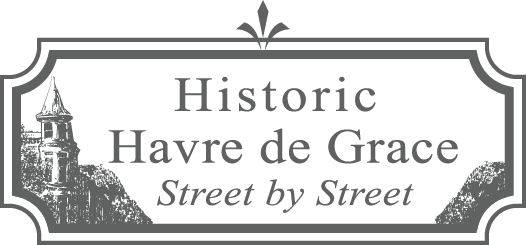Back to All Listings
701 Fountain Street, c. 1890
In August 1889 the Mayor and City Council agreed to allow John Faust & Son to construct a shoe factory here that would be exempt from city taxes for 50 years. It was renamed as Faust Schocke Shoe Company, as shown on the 1890 and 1894 Sanborn Maps, but after employing about 200 people it went out of business quickly. Gambrill & Melville Mills, manufacturer of cotton damask and other textiles, closed two mills elsewhere and moved here in 1899. Their business grew to having 200 looms and appeared on the 1899, 1904, and 1910 Sanborn Maps. A news report in The Textile American
of January 1905 said that Robert G. Gambrill (1858-1941), the President, was considering moving the mill to Wilmington, Delaware, due to the scarcity of loom operators—and because “there were no houses to be had” in Havre de Grace.
It appears that “The Havre de Grace Improvement Company” (run by some of the leading businessmen of the city, including Robert K. Vanneman, A.P. McCombs, and P.L. Hopper) remedied this housing shortage by selling Lots 1-18 in Square 198 to Robert G. and Mary Gambrill. The houses became known as “Brick Row,” a group of five duplex red brick houses directly across Fountain Street (they first appeared on the 1894 Sanborn Insurance Map). The Improvement Company was known to supply sites and property to prospective businesses to encourage them to locate in Havre de Grace.
In 1914, Carrie Lawrence’s mother operated a loom for the Gambrill’s as did the mother of D. Everett Wilson. And Carrie Lawrence recalled that the Mill owners, the two Gambrill brothers, were the first Havre de Grace residents to buy an automobile. Gambrills Mill had its own “Textile Band” that played when buyers arrived at their manufacturing facility.
In 1921, Sanborn Maps show the Princess Weaving Mill (which went into receivership in 1921) while 1930 shows the Harford Mills, Inc., manufacturers of cotton textiles, and Margerson Binns Company, which made towels. Harford Mills advertised its machinery and looms for sale in the Democratic Ledger
in 1935, before they closed down.
But big news came from The Morning News
from Wilmington, Delaware, when it announced on October 30, 1933:
"Havre de Grace to Get Distillery A deal for the purchase of the old textile plant near the Havre de Grace High School has been consummated for a Baltimore Corporation for use as a distillery. C.A. McCommons, contractor, has put 25 men to work in remodeling the building in order that operation may start after the repeal of the Eighteenth Amendment. About 50 persons will be given employment when the concern, to be known as the Harford Distillery Incorporated, starts operation.”
"Havre de Grace to Get Distillery A deal for the purchase of the old textile plant near the Havre de Grace High School has been consummated for a Baltimore Corporation for use as a distillery. C.A. McCommons, contractor, has put 25 men to work in remodeling the building in order that operation may start after the repeal of the Eighteenth Amendment. About 50 persons will be given employment when the concern, to be known as the Harford Distillery Incorporated, starts operation.”
Harford Distillery came first, followed Harford Pure Rye and Calvert Brand Whiskey. The Lansdowne Distillery is known to have “reopened” in Havre de Grace and copyrighted the “Lansdowne Reserve” label in 1942. At that time tokens were made by whiskey manufacturers to promote their products. Lansdowne created spinner tokens with a “bump” on one side to serve as a spinning point and an arrow on the other side (usually used to determine who bought the next round of drinks). Such everyday items, as well as Victorian trade cards, are now considered collectibles. The name of an E.M.F. Distillery in Havre de Grace shows up in a 1944 catalog of distilleries. Research also shows the Harford County Distillery, Inc., in Havre de Grace as an “authorized federally funded facility in WWII” with a product, “Alcohol, 190 Proof, Dried soluble resulting from production of alcohol.”
It doesn’t seem surprising that locals, such as Hilda Parsons, recall the strong smell of whiskey in town. Connie Farro Richardson said they could smell the sour mash all day long sitting in the old elementary school, particularly with windows open due to not having air-conditioning. And William R. Pyle remembers being dismissed early from the elementary school due to the odor; he also says there was a big Lansdowne sign on the smoke stack that was visible from Juniata Street.
The first silica plant for Huber Engineered Materials, a business unit of the J.M. Huber Corporation, opened here in 1952 when it took over the defunct alcohol distillery. Jack Lill had been the manager of the Chemicals Division and toured all over the east coast in the 1950s looking for the best place for a silica plant. He selected Schindley’s Whiskey Distillery in Havre de Grace. Huber occupied about 14 acres of land, with offices also at 907 Revolution Street. In 1961, Huber expanded by razing its building on Adams Street and putting up five 65-foot-tall silos that were 30 feet in diameter. They were used for storing finished products.
In mid-2017, Huber was bought by Evonik Industries. Evonik, a global specialty chemicals company based in Germany, supplanted Huber’s iconic name in Havre de Grace—it was one of Havre de Grace’s largest and oldest manufacturing operations.
The original office of all these businesses still stands today at 701 Fountain Street and three of the five original duplexes of “Brick Row” remain and are independently owned.
County Records
Industrial property, 94,704 sq ft building, 3.1 acres, owned by Evonik Industries.
Industrial property, 94,704 sq ft building, 3.1 acres, owned by Evonik Industries.
